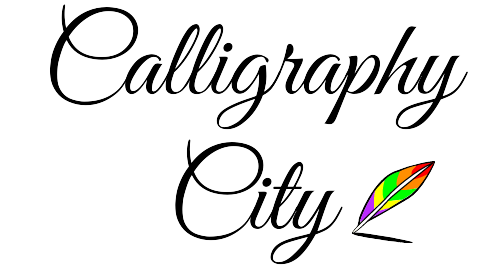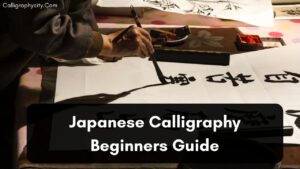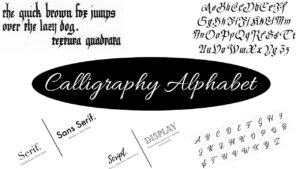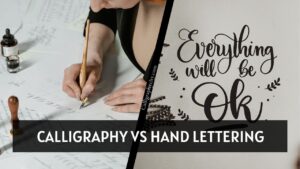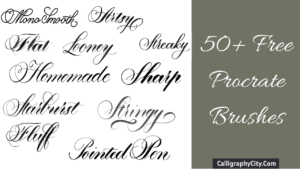How to Write in Calligraphy 7 Things You Need to Know
How to write in Calligraphy, the art of writing beautifully with a special pen or brush.
It is a set of skills and techniques for positioning and inscribing words, so they show integrity, harmony, and some sort of ancestry rhythm and creative fire.
Calligraphy is basically associated with China.
Different forms of calligraphy have been originated from different and various countries.
Calligraphy means more than just beautiful handwriting.
It is true that according to Greek derivation calligraphy means beautiful writing. But this word has a larger meaning.
Bear in mind that the first goals of handwriting are to be quickly and easily written and accurately read.
Clarity and speed impact in handwriting is much more important than beauty, personality, and art.
We say that calligraphy is handwriting kinda thing and even some handwriting appears to be calligraphic, but they are not some.
The difference between handwriting and calligraphy is ‘art form’ and ‘artistic looking handwriting’.
The main aim of calligraphy is to produce art. So that, the artist could display a deeper meaning to the viewer.
And, the viewer feels invited to think a new thought in response. Handwriting, by contrast, aims to be read.
Father of writing calligraphy:
Edward Johnston – He studied published copies of manuscripts by architect William Harrison Cowlishaw.
He did introduce to William Lethaby in 1898, principal of the Central School of Arts and Crafts, who advised him to study manuscripts at the British Museum.
History of Calligraphy Letters
At least once this question has arisen in our mind that from where calligraphy came?
It is estimated that the Romans were the first to really bring calligraphy to the masses –
we only have to take a look at many of the statues throughout Italy or Roman remains in the UK to see the strikingly beautiful lettering that they painstakingly carved.
They did also write in this style!
Humans have been looking for the most decorative and beautiful way to display their writing, from the moment when the first quill hit the first piece of parchment.
Modern Calligraphy Letters
We have seen the arrival of type families that incorporate characters from many writing systems within one overarching design, a useful feature in today’s global marketplace.
BBC Reith, for example, is a new typeface family produced for the British broadcaster by type designers Dalton Maag.
In the context of an art gallery, calligraphy, handmade lettering, signwriting all these flourishes, at the local level and even sometimes with a conceptual twist.
The world’s major writing systems are getting affected due to the creation of an art market for fine typography and calligraphy.
One of the most innovative developments in recent years has been graffiti.
For the first time, we have seen a new style of writing develop within youth culture, an unanticipated side-effect of a century of effort to provide universal education.
Graffiti has become a worldwide phenomenon at the beginning of the 1970s in the eastern United States spreading a lot of the world’s writing systems.
In modern days, digital fonts have taken the place of calligraphy.
The art of calligraphy has somehow lost its glory and luster with the passing of time.
But, still calligraphy is prevailing and many bloggers use the concept of Brush lettering, boutique businesses to give the organic and handmade touch to their lines.
Here are some of the things related to writing calligraphy:
Calligraphy Fonts
Calligraphy fonts resemble elegant handwriting.
These fonts look as if they were drawn with flat-tipped pens or brushes.
Calligraphy fonts are basically used in
- Weddings
- Event invitations
- Original logo design
- Religious art
- Films
- TV
Burgues Script is one of the typical font families of calligraphy styles which is created by Alejandro Paul.
According to the designer, the font is an ode to the late nineteenth-century American calligrapher Louis Madarasz, known as “the most skillful penman the world has ever known.”
Calligraphy Alphabets
There are almost infinite ways to make variations of twenty-three letters of the alphabet, some of them can be more elaborate than others.
It is tricky to understand letter shapes, styles, and families.
For developing our own calligraphic alphabet, the first thing which we need to do is understanding the different families and styles that are backbones and staples of all alphabets.
Calligraphy Pens
Calligraphy pens nibs are flat, round, or pointed.
For some decorative writing, artists write with calligraphy pens with nibs that :
- flat
- round
- pointed
- Multi-nibbed pens
- steel brushes
can be used for decorative purposes.
However, works have also been created with felt-tip and ballpoint pens, although these works do not employ angled lines.
There are some styles of calligraphy, such as
- The Gothic script, which requires a stub nib pen.,
- multi-nibbed pens
- steel brushes
We also do calligraphy work with felt-tip and ballpoint pens, although this work does not employ angled lines. The gothic script is one of the styles of calligraphy, that needs a stub nib pen.
Some of the common calligraphy pens and brushes are-
- Quill,
- Dip pen,
- Ink brush,
- Qalam,
- Fountain pen.
We often think that we should also know calligraphy.
how to write in Calligraphy or how to do calligraphy?
There are two methods if we know we can easily write calligraphy.
First method
So, here we follow some of the basic learning tips for writing calligraphy.
First, hold our pen diagonally at a thirty to sixty-degree angle.
A calligraphy pen isn’t used quite the same way as a regular pen.
The tip or nib of the pen should point diagonally away from us, to the left, as we write.
The second, step is that do not twist the nib as we write.
Third, lead is the nib backward or sideways across the paper.
The fourth step which we need to follow is applied light pressure.
And, always remember that keep your lines parallel.
Second method
It is practicing letters and words. In this method, we need to trace the alphabet numerous times.
We need to select and point a sample calligraphy alphabet and cover it with a piece of tracing paper.
Try to recreate the strokes of the calligraphy letters until we can successfully write the letters on our own.
This is how from which we can easily write or design calligraphy.
When we design this then we understand that how beautiful it looks.
It is a beautiful art and has its own importance among other fonts.
Conclusion
I hope this article will help you to start your calligraphy journey.
One thing you need to remember that keep practices those basic strokes that we will provide in this article and select the right pen read all the steps carefully and follow them.
It takes time to master anything so don’t get in a rush to keep the claim and keep practices follow the process.
